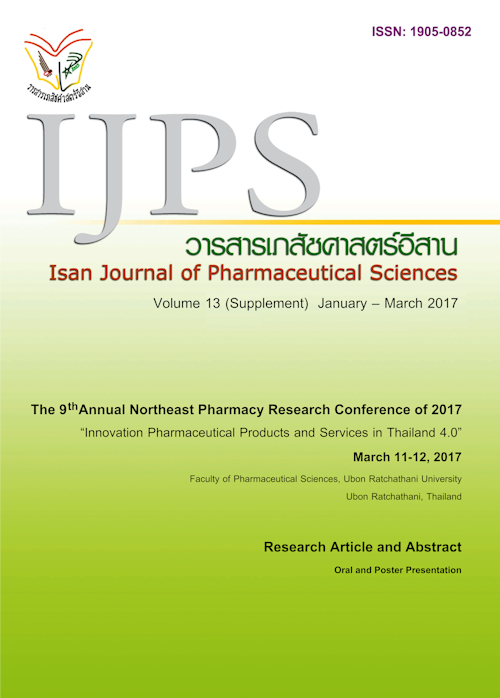Physical Exercise Behavior among Pharmacy Studentsaccording to the Transtheoretical Model
Main Article Content
Abstract
Introduction: This research aimed to investigate exercise behavior of pharmacy students in Northeastern Thailand based on the Transtheoretical model (TTM). Methods: A cross-sectional study was conducted. The samples were pharmacy students at three institutes, including Ubon Ratchathani University, Mahasarakham University and Khon Kaen University during the 2016 academic year. Data was collected by online questionnaires according to the Transtheoretical model. Descriptive statistics and binary logistic regression were used for analysis Results: Four hundred ninety students voluntarily participated in this study. About three-fourths were female (75.31%) Most participants were Ubon Ratchathani university students (70.82%) About half had normal body mass index (54.69%) Most of the participants were lack of exercise. Based on TTM, they were classified as in preparation contemplation and precontemplation (43.1%, 21.4% and 10.0% respectively). Mean scores of self-efficacy and processes of change constructs were at medium level (2.54 + 0.53 and 2.60 + 0.47 respectively, range 1 to 4) Decisional balance score was high (3.08 + 0.39). Based on binary logistic regression, participants} exercise stages were divided into two groups as active stage (action and maintenance) and inactive stage (precontemplation, contemplation and preparation). There were statistically significant association between exercise stage and gender, self-efficacy and processes of change. Male were higher in exercise active stage as compared to female (Odds ratio = 2.26 (95% CI = 1.37 - 3.72). Self-efficacy and processes of change constructs had positive association with exercise active stage (Odds ratio = 2.50 (1.46 - 4.28) and Odds ratio = 3.92 (2.12 g 7.25) respectively). Conclusions: Finding shows that most pharmacy students were in the inactive stage for exercise. Universities should create campaigns on exercise behavior by implementing stage- matched intervention and placing a focus on female students as well as self-efficacy development.
Article Details
In the case that some parts are used by others The author must Confirm that obtaining permission to use some of the original authors. And must attach evidence That the permission has been included
References
Boonchuaykuakul J. Effectiveness of applying the transtheoretical model to improve physical activity behavior of university students. [doctoral dissertation], Oregon State University Corvallis; 2005.
Centers for Disease Control and Prevention [Internet]. Atlanta: Centers for Disease Control and Prevention. 2015 [updated 2015 June 4; cited 2016 May 9]. Physical Activity and Health. Available form: http://www.cdc.gov/physicalactivity/basics/pa-health/index.htm#ReduceCancer
Chomsuan J, Promyai S. Health Status In Pharmacy Students, Mahidol University. 2007 [cited 2016 December 11]. Available form: http://www.pharmacy.mahidol.ac.th/th/service-research-special-abstract.php?num=42&year=2550
Kim Y. A Stage-matched intervention for exercise behavior change based on the Transtheoretical model. Psychol Rep.2008; 102: 939-950.
Marcus BH, Selby VC, Niaura RS, Rossi JS. Self-efficacy and the stages of Exercise behavior change. Res Q Exerc Sport. 1992; 63: 60g66.
Narin J, Taravut T, Sangkoumnerd T, et al. Prevalence and factors associated with sufficient physical activity among medical students in Khon Kaen University. SMJ 2007; 24(4) 389-395.
National Statistical Office. Ministry of Information and Communication Technology. Survey on population behavior in playing sport or physical exercise and mental health, 2011. 2012 [cited 2016 May 9]. Available form: http://service.nso.go.th/nso/web/survey/surpop2-4-2.html
Panidchakul K, Samranbua A. An Application of Transtheoretical Model to Promote Exercise. The Journal of Boromarajonani College of Nursing, Nakhonratchasima. 2013; 1: 66-76
Prochaska JO, DiClemente CC. Stages and processes of self-change of smoking: Toward an integrative model of change. J Consult Clin Psychol. 1983; 51: 390-395.
Somnil P. Factors associated with exercise behavior of university students in the northeast, upper Thailand. JSST 2015; 15(2): 419-28.
Spencer L, Adams TB, Malone S, Roy L, Yost E. Applying the Transtheoretical model to exercise: A systematic and comprehensive review literature. Health Promot Pract. 2006; 7: 428-43.
Tansakul C. Public Health Behavioral sciences. 3rd ed. Bangkok: 2000 Thitirattanachot C, Laukongtam N, Mawong W, Sriboonruang T, Phattarabenjapol S. Assessment of mental health and stress of students at Ubon Ratchathani university. IJPS. 2014; 9: 66-71
Watcharathanakij S, Moolasarn S, Phanritdam S, Noobome M. Physical Exercise Behavior of Ubon Ratchathani University Undergraduate Students. IJPS. 2012; 8(3): 35-47.
World Health Organization. Recommended population levels of physical activity for health. Global recommendations on physical activity for health. 2010:23-27


